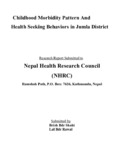Please use this identifier to cite or link to this item:
https://hdl.handle.net/20.500.14356/323Full metadata record
| DC Field | Value | Language |
|---|---|---|
| dc.contributor.author | Nepal Health Research Council (NHRC) | |
| dc.contributor.author | Shahi, Brish Bdr | |
| dc.contributor.author | Rawal, Lal Bdr | |
| dc.date.accessioned | 2013-01-01T21:15:09Z | |
| dc.date.accessioned | 2022-11-08T10:14:21Z | - |
| dc.date.available | 2013-01-01T21:15:09Z | |
| dc.date.available | 2022-11-08T10:14:21Z | - |
| dc.date.issued | 2007 | |
| dc.identifier.uri | http://103.69.126.140:8080/handle/20.500.14356/323 | - |
| dc.description.abstract | Summary: Jumla is a mountainous District that lies in Karnali Zone. Health status as well as health services in the district are very miserable. To provide preventive, promotive and curative health services for around 89,000 populations, 1 district hospital,1 PHC, 8 health Posts and 20 Sub Health Posts have been established. This research aims to explore childhood morbidity pattern and practice of health seeking during illness in the district where virtually no research activities happen. Further, both childhood morbidity and health seeking behaviors are compared with various indigenous and social factors. This research is representative for the whole districts though only 30 wards of 14 VDCs were selected for the sampling. Around 300 children were selected by WHO 30 cluster sampling for the study however only respondent of 278 children were available for the study. Sampling method was of probability type. Data were entered and analyzed in computer program SPSS and statistical inferences is drawn on the basis of percentage, mean and chi-square test. The study period was of around three months. It is a descriptive and cross sectional study and target population is under five children. Study was for the period of 1st Chaitra 2062 to 30th Falgun 2063. To get the inferences, statistical tools like chi-square test and mean are used. Finally the results will be used to improve health service delivery and better service utilizations. Among the respondents, 54 percent are male and 46 percent are female. Children of under 1 years are 43.9 percent where as above 49 years are only 2.2. Similarly 19.1 percent of children are of birth order 1st. Uneducated respondents are 85.8 percent and 58.4 percent are farmers. Four in five respondents have at least one member smoking in the family. Slightly majority of the respondents were from joint families which reveals culture of living together is strong in Jumla. More than half of respondents have modified Chulo in the household and two in one family are using toilet. Slightly more than half of respondents have access of Health Institution within one hours of walking distance and 37 percent have no access within one Hour of walking distance. In the period of last two weeks, 60.9 percent children were exposed to any type of illness. Among them, 72.7 percent felt only one type of illness where as 21.8 and 5.5 percent felt illness of two and 3 or more than 3 types of diseases respectively. Cough and cold was the most leading cause of illness with 56 percent of children had its symptoms. Second leading is Diarrhoea and Dysentry with 21.8 percent third is Pneumonia with 9.2 percent. Two weeks incidence of disease is significantly associated with the house hold notusing toilet (p = 0.017) and living away from one hour of distance from health institution (p = 0.036). Two weeks incidence is also higher among uneducated mothers, farmers, laborers and housewives. Similarly Joint families and having traditional house hold are also more likely to be exposed to sickness. The proportion of mothers who sought modern health care for two weeks incidence is 46.1 percent, Home treatment 26.9 percent, traditional treatment 7.8 and doing nothing is 19.2 percent. Highest proportion of people sought the special care because it was easily available 38.1 percent where as 27.4 percent preferred it. More than two in three mothers take service from either Health Worker or Health Institution and more than one in four visited FCHV first among the people who sought for modern health care. On the other hand more than 50 percent felt lack of time or service unavailable to take service from health care providers. Treatment failure rate was highest among traditional healers 50% and lowest among modern health care seekers 3 percent not (condition worsened and not changed). Treatment success rate is better in home treatment than that of doing traditional treatment or doing nothing. In an average, one child suffered 2.1 episodes of illness during last one year, and maximum episode was 12. They waited in an average 57.2 days in ear infection, 9.3 days in skin infection and 3.0 days for diarrhoea to seek health care. Diarrhoea and Pneumonia are felt most serious disease in Jumla. Feeding practices during diarrhoea is not satisfactory and just one in ten respondent know proper home care of cough and cold. Home treatment of fever and ear infection is horrible and harmful, unfortunately majority are pursuing it. | en_US |
| dc.language.iso | en_US | en_US |
| dc.publisher | Nepal Health Research Council | en_US |
| dc.title | Childhood Morbidity Pattern and Health Seeking Behaviors in Jumla District | en_US |
| dc.type | Technical Report | en_US |
| Appears in Collections: | NHRC Research Report | |
Items in DSpace are protected by copyright, with all rights reserved, unless otherwise indicated.

